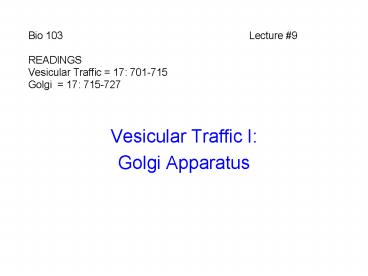Bio 103 Lecture PowerPoint PPT Presentation
1 / 34
Title: Bio 103 Lecture
1
Bio 103 Lecture 9READINGSVesicular
Traffic 17 701-715Golgi 17 715-727
- Vesicular Traffic I
- Golgi Apparatus
2
Protein Sorting - Golgi
- Introduction to Golgi
- Molecular mechanisms of vesicular trafficking
- Transport from ER through Golgi
- Transport from Golgi (TGN) to lysosomes
- Glycosylation of proteins in Golgi
- Organization of Golgi and models for the
directional transport of proteins
3
Protein Sorting - Golgi
- Introduction to the Golgi Apparatus
4
16-1 Overview of major protein-sorting pathways
5
Red arrows biosynthetic-secretory
pathways Green arrows endocytic pathways Blue
arrows Retrieval pathways
13-3 (Alberts) Intracellular compartments
involved in the biosynthetic-secretory and
endocytic pathways
6
Red arrows biosynthetic-secretory
pathways Green arrows endocytic pathways Blue
arrows Retrieval pathways
13-1 Alberts Biosynthetic-secretory and
endocytic pathways
7
Protein Sorting to Golgi
- Introduction to Golgi
- Molecular mechanisms of vesicular trafficking
- -Transport vesicles form from coated regions of
membranes - -Coat functions
- Concentrates transport proteins into patches
- Induce patches to vesicularize
- -Types coats
- COPII ER to Golgi
- COPI Golgi to Golgi, Golgi back to ER
- Clathrin Trans-Golgi Network (TGN), endocytosis
- -Proteins essential to vesicle function
- Monomeric GTPases control coat assembly
- EXAMPLE Coat-recruitment GTPases
- ARFs (responsible for COPI and clathrin coat
assembly) - Sar1 (responsible for COPII coat assembly)
- SNARE proteins guide vesicles (mediate vesicle
fusion?) - Rab proteins ensure specificity of vesicle docking
8
13-22 (Alberts) The Golgi Apparatus
9
13-2 Transport vesicles bud from one compartment
and fuse with another
10
17-7 Mechanism of vesicle budding and fusion
11
17-8 EM of an in vitro budding reaction
involving COPII and liposomes
12
13-5 (Alberts) Utilization of different coats in
vesicular traffic
13
Protein Sorting - Golgi
- Introduction to Golgi
- Molecular mechanisms of vesicular trafficking
- -Transport vesicles form from coated regions of
membranes - -Coat functions
- -Types coats
- -Proteins essential to vesicles
- Monomeric GTPases control coat assembly
- SNARE proteins guide vesicles (mediate vesicle
fusion?) - Rab proteins ensure specificity of vesicle
docking - Transport from ER through Golgi
- -Proteins leave ER in COPII-coated vesicles
- -Resident ER proteins have to be retreived from
Golgi - Resident ER membrane protein retrieval signal
KKXX - Resident ER soluble protein retrieval signal
KDEL
14
17-9 Role of Sar1 in assembly and disassembly of
COPII coats
15
17-11 Model for docking and fusion of transport
vesicles with their target membranes
16
17-14 Vesicle-mediated protein trafficking
between ER and Golgi
17
13-21a (Alberts) Model for the retrieval of ER
resident proteins
18
13-21b (Alberts) Model for the retrieval of ER
resident proteins
19
17-18 Involvement three major coat proteins in
vesicular trafficking
20
17-19 Structure of clathrin coats
21
EM of clathrin cages
22
13-8 (Alberts) Assembly and disassembly of the
clathrin coat
23
Protein Sorting - Golgi
- Introduction to Golgi
- Molecular mechanisms of vesicular trafficking
- Transport from ER through Golgi
- Transport from Golgi (TGN) to lysosomes
24
17-23 Trafficking of soluble lysosomal enzymes
from TGN and cell surface to lysosomes
25
13-31 (Alberts) Lysosomes and their components
26
13-35 (Alberts) Three pathways to degradation in
lysosomes
27
13-37a (Alberts) Transport of newly synthesized
lysosomal hydrolases to the lysosome
28
13-37a (Alberts) Transport of newly synthesized
lysosomal hydrolases to the lysosome
29
Protein Sorting - Golgi
- Introduction to Golgi
- Molecular mechanisms of vesicular trafficking
- Transport from ER through Golgi
- Transport from Golgi (TGN) to lysosomes
- Glycosylation of proteins in Golgi
30
13-28 (Alberts) Histochemical stain showing the
biochemical compartmentalization of the Golgi
31
13-29 The functional compartmentalization of the
Golgi
32
Protein Sorting - Golgi
- Introduction to Golgi
- Molecular mechanisms of vesicular trafficking
- Transport from ER through Golgi
- Transport from Golgi (TGN) to lysosomes
- Glycosylation of proteins in Golgi
- Organization of Golgi and models for the
directional transport of proteins
33
13-30 Two possible models explaining the
organization of the Golgi Apparatus and the
transport of proteins from one cisternae to the
next
34
Protein Sorting - Golgi
- Introduction to Golgi
- Molecular mechanisms of vesicular trafficking
- -Transport vesicles form from coated regions of
membranes - -Coat functions
- -Types coats
- -Proteins essential to vesicles
- Monomeric GTPases control coat assembly
- SNARE proteins guide vesicles (mediate vesicle
fusion?) - Rab proteins ensure specificity of vesicle
docking - Transport from ER through Golgi
- -Proteins leave ER in COPII-coated vesicles
- -Resident ER proteins have to be retreived from
Golgi - Resident ER membrane protein retrieval signal
KKXX - Resident ER soluble protein retrieval signal
KDEL - Transport from Golgi (TGN) to lysosomes
- Glycosylation of proteins in Golgi
- Organization of Golgi and models for the
directional transport of proteins

